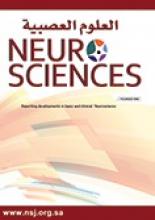Abstract
OBJECTIVE: To report our experience with lamotrigine (LTG)-related skin rash in children with epilepsy.
METHODS: We identified a series of consecutive children with epilepsy treated with LTG prospectively over a 5-year period ending 1st October 2005 at King Abdul-Aziz University Hospital and King Faisal Specialist Hospital and Research Center, Jeddah, Kingdom of Saudi Arabia.
RESULTS: Of 207 children on LTG, 15 (7.2%) developed a skin rash with ages ranging between 3-12 years (mean 7.5). We used LTG as monotherapy in 3/15 and as add on in 12/15, mostly (10/15) in addition to valproic acid (VPA). The rash was mild with complete recovery in 7 children (47%). The remaining 8 (3.9% of the total) had severe rash that necessitated admission to hospital. Seven out of these 8 children were also receiving VPA. One child had superimposed secondary bacterial infection and admitted for intravenous antibiotics. Two children recovered slowly with extensive post-inflammatory hyperpigmentation. We diagnosed Stevens-Johnson syndrome in 5 children (2.4% of the total). One of these 5 children had progressive symptoms that evolved to toxic epidermal necrolysis. He required prolonged intensive care admission and developed sepsis with disseminated intravascular coagulopathy. He deteriorated despite supportive therapy, and died 5 weeks after the initiation of LTG therapy.
CONCLUSION: Lamotrigine is a novel antiepileptic drug with a favorable therapeutic profile and good tolerability. However, LTG-related skin rash is a potentially serious adverse event that should be carefully monitored. Although the risk is small, one should weigh this against the potential benefits, particularly in children on VPA.
- Copyright: © Neurosciences
Neurosciences is an Open Access journal and articles published are distributed under the terms of the Creative Commons Attribution-NonCommercial License (CC BY-NC). Readers may copy, distribute, and display the work for non-commercial purposes with the proper citation of the original work.






